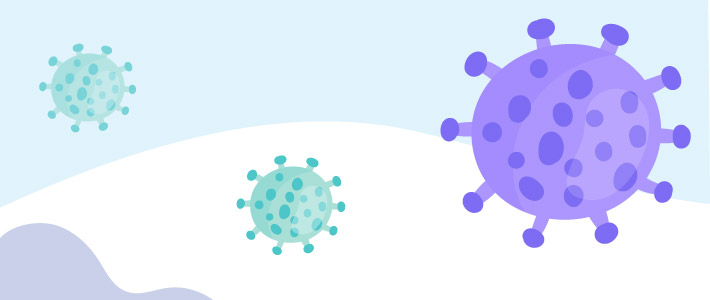August 2022
Table of Contents:
Section 1: Overview
Section 2: Patient Presentation
Section 3: Infection Prevention / Precautions
Section 4: Testing and Reporting
Section 5: Treatment
Section 6: Prophylaxis
Section 1: Overview
Monkeypox is a rare infection caused by the Monkeypox virus. While this virus is classified in the same family as the variola virus which causes smallpox, symptoms are generally milder and rarely fatal. Cases outside of central and western Africa were previously uncommon and linked to imported animals. An outbreak of Monkeypox has been spreading across several countries, including the United States. The Center for Disease Control and Prevention’s U.S. Monkeypox Case Trends Reported to CDC can be utilized to track cases.
Section 2: Transmission & Patient Presentation
Transmission of the current outbreak is primarily through close, intimate contact with someone who has Monkeypox (direct body/contaminated clothes contact, respiratory secretions). Incubation after exposure is roughly 1-2 weeks. The virus can spread to a fetus through the placenta.
Patient presentation is similar to the clinical course of ordinary discrete smallpox. Initial prodromal symptoms include:
- Fever
- Malaise
- Headache
- Weakness
- Sore throat / cough
- Lymphadenopathy (submandibular, cervical, axillary, inguinal)
Shortly after the prodrome, a rash and lesions begin to develop on any given part of the body. Lesions progress through four stages including macular → papular → vesicular → pustular → scabbing / resolving. Severity of illness is dependent on baseline patient health, route of exposure, and strain of the virus. Symptoms generally resolve after 2-4 weeks. Patients are no longer contagious once scabs have resolved and normal skin forms underneath.

Section 3: Infection Prevention & Precautions
a. Screen and act fast to isolate patient (Contact+Droplet+Respirator)
b. Ensure private room and personal protective equipment (PPE) is available:
- Gowns, gloves, eye protection and N95/N100
- A negative pressure room is not required unless performing an aerosol generating procedure.
c. Use hospital disinfectants with ‘emerging viral pathogen’ claim
d. Report all suspected and confirmed cases to Infection Prevention for public health reporting.
e. Healthcare personnel (HCP) potentially exposed to confirmed cases will be notified by management. Exposed HCP should self-monitor themselves for symptoms and will be given these forms from Associate & Occupational Health (AOH).
Section 4: Testing and Reporting
Testing for Monkeypox infection includes preliminary testing for non-variola orthopoxvirus. Orthopoxvirus positive results during the current pandemic are presumed to be Monkeypox given the lack of other orthopoxviruses circulating in the United States. Swabs from two lesions in separate parts of the body should be collected. Vigorous swabbing is recommended to collect adequate DNA. De-roofing of the lesion prior to swabbing is unnecessary. Break off the end of each swab’s applicator into a 1.5-or 2-mL screw-capped tube with O-ring or place the entire swab in a sterile container that has a gasket seal and is able to be shipped under the required conditions. Refer to local state Department of Health and Infection Prevention instructions for specific specimen collection, shipping, and reporting requirements. Other tests may be required as well, including chickenpox, herpes, syphilis, etc.
Section 5: Treatment
In most cases, Monkeypox infection will present as mild and self-limiting in the absence of a specific therapy. For severe disease or patients at high-risk for severe disease, use of the antiviral t tecovirimat(SIGA) may be beneficial. Current supply is limited therefore procurement via the expanded access investigational new drug protocol (EA-IND), also known as “compassionate use”, from the Strategic National Stockpile (SNS) is required.
Risks of using available alternative therapeutics may not outweigh potential benefits. Therefore alternative agents are not recommended at this time unless tecovirimat is unavailable and after shared decision-making.
Refer to the CDC Monkeypox – Information for Healthcare Professionals for more information.
| Tecovirimat (SIGA) – EA-IND Protocol, Package Insert | |
| Indications | FDA-approved for the treatment of smallpox in adults and children weighing at least 3 kg. CDC holds an EA-IND also known as “compassionate use” for treatment of Monkeypox. Efficacy data against Monkeypox is derived primarily from animal studies. |
| Mechanism of Action | Inhibitor of the orthopoxvirus VP37 envelope wrapping protein |
| Criteria for Use | Limited supply available therefore use is restricted to the treatment of confirmed active Monkeypox infection in individuals meeting at least one of the following criteria:Severe disease (e.g., hemorrhagic disease, confluent lesions, sepsis, encephalitis, or other conditions requiring hospitalization).At high risk of severe disease:Immunocompromising conditionsPediatric populations, (< 8 years of age)Pregnant or breastfeeding womenHistory or presence of atopic dermatitis or other active exfoliative skin conditionsOne or more complication (e.g., secondary bacterial skin infection; gastroenteritis with severe nausea/vomiting, diarrhea, or dehydration; bronchopneumonia; concurrent disease or other comorbidities)Aberrant infections involving accidental implantation in eyes, mouth, or other anatomic areas where Monkeypox virus infection might constitute a special hazard |
| Use of the IV formulation is restricted to the following patients:Unable to swallow and unable to have a nasogastric tube safely placedObtunded and unable to protect airway for safe administration of oral medications via mouth of nasogastric tubeNon-functional GI tract secondary to malabsorption or other severe disease of the GI tract | |
| Formulations / Dosing | Oral 200 mg capsules:< 6 kg: 50 mg every 12 hours for 14 days6 to < 13 kg: 100 mg every 12 hours for 14 days13 kg to < 25 kg: 200 mg every 12 hours for 14 days25 kg to < 40kg: 400 mg every 12 hours for 14 days40 kg to < 120 kg: 600 mg every 12 hours for 14 days≥ 120 kg: 600 mg every 8 hours for 14 daysInstructions for patients unable to swallow capsules or doses that require opening of the capsule can be found in Attachment 3 of the EA-IND Protocol.Take within 30 minutes of a full meal containing moderate or high fat.Intravenous 200 mg / 20 mL vial (store in refrigerator at 2°C to 8°C [36°F to 46°F]):< 35 kg: 6 mg/kg every 12 hours over 6 hours for up to 14 days35 kg to < 120 kg: 200 mg every 12 hours over 6 hours for up to 14 days≥ 120 kg: 300 mg every 12 hours over 6 hours for up to 14 daysSwitch to capsules to complete the 14 day treatment course as soon as oral therapy can be tolerated and is appropriate clinically.IV Preparation:Prepare dose in a syringe; do not use prefilled infusion bags for dose preparation.Withdraw appropriate amount of tecovirimat for dose into syringe; to the same syringe, add 2 times the tecovirimat dose volume of either NS or D5W. (Two separate syringes may be needed to deliver entire dose depending on the size of syringe available with syringe pump system.)Gently swirl syringe(s) prior to inserting into the syringe pump.Discard unused portion of vial; do not reuse.Refer to the EA-IND Protocol for more information. |
| Warnings / Adverse Events | Contraindications:Capsules (none)Injection (severe renal impairment, CrCl < 30 mL/min, due to risk for excipient [cyclodextrin] accumulation)Adverse Events:Capsules: headache, nausea, abdominal pain, vomitingInjection: injection site reactions, headache |
| Pregnancy / Lactation: No human data available at this time. Animal data does not show evidence of reproductive harm. Use requires shared decision-making between the local/state health department, CDC, the patient’s provider, and the patient or caregiver themselves. | |
| Drug Interactions | Repaglinide – increased risk for hypoglycemia requiring close monitoringMidazolam – reduced effectiveness of midazolam |
| Procurement | Refer to the CDC Guidance page, Information for Healthcare Providers on Obtaining and Using TPOXX (Tecovirimat) for Treatment of Monkeypox, for the most up-to-date procedures. Patients must be educated and consented prior to use. See Page 22 of the Package Insert for the Medication Guide. |
Section 6: Prophylaxis
JYNNEOS® (Smallpox and Monkeypox Vaccine, Live, Non-Replicating) is FDA-approved for the prevention of Monkeypox in adults and is available under Emergency-Use Authorization (EUA) for high-risk children and as an alternative regimen for high-risk adults to expand immunization access during the current pandemic. The product is being distributed by the SNS at this time and may be administered as pre-exposure prophylaxis (PrEP) or post-exposure prophylaxis (PEP) based on availability and local guidance. Refer to CDC Monkeypox – Considerations for Monkeypox Vaccination and Advisory Committee on
Immunization Practices recommendations for JYNNEOS® for more information.
| Smallpox and Monkeypox Vaccine, Live, Non-replicating (JYNNEOS®) – EUA Fact Sheet, Prescribing Information | |
| Indication | FDA-approved for the prevention of smallpox or Monkeypox in patients 18 years or older.On August 9, 2022, the FDA issued an EUA for the intradermal administration of the JYNNEOS® vaccine in adults 18 years or older at high-risk of for Monkeypox infection and for subcutaneous administration in individuals younger than 18 years of age at high-risk for Monkeypox infection. This approval will expand access to the current vaccine product by lowering the required injection volume (one fifth) for adults allowing for multiple doses per vial. Efficacy data against Monkeypox is based on clinical human and animal data. |
| Mechanism of Action | Live-attenuated Vaccinia virus |
| Criteria for Use | Vaccination as PrEP or PEP may be considered in all patients at high-risk for Monkeypox infection.Efficacy and safety has been demonstrated in patients living with HIV who are virologically suppressed with CD4 counts >100 cells/mm3,8-10 |
| Formulation / Dosing | Dosing and Administration:≥ 18 years of age: Two doses of 0.1 mL administered intradermally 28 days apart (minimum of 24 days).< 18 years of age or history of keloid scarring: Two doses of 0.5 mL administered subcutaneously 28 days apart (minimum of 24 days).Maximal immunity is achieved 14 days after second dose.Consider referring patients to the local Department of Health to reduce waste and maximize immunization given that each vial contains 5 doses and once punctured, the remaining doses in the vial expire in 8 hours.Storage:Please note that the JYNNEOS manufacturer has provided a letter indicating expanded storage at refrigerated temperatures that is not indicated in the package insert.The vaccine comes in packages of 20, 0.5mL vials.Storage of unopened vialsIf vaccine is shipped frozen at -20°C and requires storage before use, maintain:Frozen ( -20°C), if freezer capacity is available, OR Refrigerated (2-8°C). Do not refreeze.Once thawed, the vaccine may be kept at +2°C to +8°C (+36°F to +46°F) for 8 weeks.Count 8 weeks from when the vial was first thawed and mark this “beyond use” date on the vial label. If the product expiration date on the carton is earlier, write that on the vial instead.After the first puncture, vials can be stored in the refrigerator at 2°C to 8°C (36°F to 46°F) for up to 8 hours.NEVER store in a “dormitory style” storage unit. |
| Warnings / Adverse Events | Contraindications: previous severe allergic reaction to JYNNEOS® (precaution in patients with severe gentamicin, ciprofloxacin, or chicken/egg protein allergies – may require 30 minute observation period)Adverse Events: injection site pain, swelling, induration, itching, redness, fatigue, headache, muscle pain. Local reactions may be more common when the vaccine is administered via intradermal route.Pregnancy / Lactation: No human data. Animal data does not show evidence of reproductive harm. Unlikely to pose a risk of infection from the vaccine to infants during breastfeeding. |
| Drug Interactions | None |
| Procurement | Due to limited supply JYNNEOS® is being distributed by the SNS.Patients must be educated and provided the EUA Fact Sheet for Recipients or Caregivers prior to administration. |
References
- Monkeypox. Centers for Disease Control and Prevention. https://www.cdc.gov/poxvirus//index.html. Accessed August 10, 2022.
- Tecovirimat SIGA. https://www.ema.europa.eu/en/medicines/human/EPAR/tecovirimat-siga#:~:text=Tecovirimat%20SIGA%20is%20a%20medicine,happen%20following%20vaccination%20against%20smallpox..
- Petersen B. Expanded Access IND Protocol: Use of Tecovirimat (TPOXX®) for Treatment of Human Non-Variola Orthopoxvirus Infections in Adults and Children. Centers for Disease Control and Prevention. 2022.
- Rao AK, Petersen B, Whitehill F et al. Use of JYNNEOS (Smallpox and Monkeypox Vaccine, Live, Nonreplicating) for Preexposure Vaccination of Persons at Risk for Occupational Exposure to Orthopoxviruses: Recommendations of the Advisory Committee on Immunization Practices — United States, 2022. MMWR Morb Mortal Wkly Rep 2022;71:734–742. DOI: http://dx.doi.org/10.15585/mmwr.mm7122e1.
- JYNNEOS (Smallpox and Monkeypox Vaccine, Live, Non-replicating) [package insert]. DK-3490 Kvistgaard, Denmark: Bavarian Nordic A/S. 2021.
- Monkeypox Update: FDA Authorizes Emergency Use of JYNNEOS Vaccine to Increase Vaccine Supply. U.S Food and Drug Administration. https://www.fda.gov/news-events/press-announcements/monkeypox-update-fda-authorizes- emergency-use-jynneos-vaccine-increase-vaccine-supply. Accessed August 10, 2022.
- Fact sheet for healthcare providers administering vaccine: Emergency Use Authorization of Jynneos (smallpox and monkeypox vaccine, live, non-replicating) for prevention of monkeypox disease in individuals determined to be at high risk for monkeypox infection. US Food and Drug Administration. Authorized August 9, 2022. Accessed August 10, 2022.
- Overton ET, Stapleton J, Frank I, et al. Safety and Immunogenicity of Modified Vaccinia Ankara-Bavarian Nordic Smallpox Vaccine in Vaccinia-Naive and Experienced Human Immunodeficiency Virus-Infected Individuals: An Open-Label, Controlled Clinical Phase II Trial. Open Forum Infect Dis. 2015;2(2):ofv040.
- Greenberg RN, Overton ET, Haas DW, et al. Safety, immunogenicity, and surrogate markers of clinical efficacy for modified vaccinia Ankara as a smallpox vaccine in HIV-infected subjects. J Infect Dis. 2013;207(5):749-758.
- Overton ET, Lawrence SJ, Stapleton JT, et al. A randomized phase II trial to compare safety and immunogenicity of the MVA-BN smallpox vaccine at various doses in adults with a history of AIDS. Vaccine. 2020;38(11):2600-2607. doi:10.1016/j.vaccine.2020.01.058









